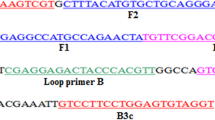Summary
A polymerase chain reaction (PCR) technique was developed and evaluated for the detection of flaviviruses. A set of sense and antisense oligomeric DNA primers were constructed from nucleotide sequences of the conserved region of the genome of several different flaviviruses. Virus specific complementary DNA (cDNA) was prepared by reverse transcription of total RNA extracted from infected cell cultures. Amplified cDNA was identified by nucleic acid hybridization with specific oligomeric internal probes. Various conditions, such as number of cycles and annealing temperature were examined to optimize the detection of viral RNAs from infected cell cultures. Slot blot hybridization with a radioative probe was used to evaluate the sensitivity of PCR amplification. The PCR amplified RNA sequences of dengue 2 (DEN-2), West Nile (WN), St. Louis encephalitis (SLE) and Kunjin (KUN) virus and detected 0.1 to 1 pg of viral RNA. Japanese encephalitis (JE), Yellow Fever virus (YF), DEN-1, 3, and 4 viruses were not amplified. The more frequent occurrence of mismatches in the 3′ primer binding site may explain the failure to amplify cDNA of these viruses.
Similar content being viewed by others
References
Castle E, Nowak T, Leidner U, Wengler G, Wengler G (1985) Sequence analysis of the viral core protein and the membrane associated protein V1 and NV2 of the Flavivirus West Nile virus and of the genome for these proteins. Virology 145: 227–236
Chomozynski P, Sacchi N (1987) Single step method of RNA isolation by acid guanidine thiocyanate-phenol-chloroform extraction. Anal Biochem 162: 156–159
Coia G, Parker MD, Speight G, Byrne ME, Westaway EG (1988) Nucleotide and complete amino acid sequences of kunjin virus. J Gen Virol 69: 1–21
Deubel V, Laille M, Hugnot JP, Chungue E, Guesdon JL, Drouet MT, Bassot S, Chevrier N (1990) Identification of dengue sequences by genomic amplification: rapid diagnosis of dengue virus serotypes in peripheral blood. J Virol Methods 30: 41–54
Eldadah ZA, Asher DM, Godec MS, Pomeroy L, Goldfarb LG, Feinstone SM, Levitan H, Gibbs CJ Jr, Gajdusek CD (1991) Detection of flavivirus by reverse transcriptase polymerase chain reaction. J Med Virol 33: 260–267
Garson JA, Tedder RS, Briggs M, Tuke P, Glazebrook JA, Trute A, Parker D, Barbara JAJ, Contreras M, Aloysius S (1990) Detection of hepatitis C viral sequences in blood donations by nested polymerase chain reaction and prediction of infectivity. Lancet i: 1419–1422
Hahn YS, Galler R, Hunkapillar T, Dalrymple JM, Straus EG (1988) Nucleotide sequence of dengue-2 RNA and comparison of the encoded proteins with those of other flaviviruses. Virology: 167–180
Halstead SB (1988) Pathogenesis of dengue: challenges to molecular biology. Science 239: 476–481
Henchal EA, Gentry MK, McCown JM, Brandt WE (1982) Dengue virus specific and flavivirus group determinants identified with monoclonal antibodies by indirect immunofluorescence. Am J Trop Med Hyg 31: 830–836
Henchal EA, McCown JM, Seguin MC, Gentry MK, Brandt WE (1983) Rapid identification of dengue virus isolates by using monoclonal antibodies in an indirect immunofluorescence assay. Am J Trop Med Hyg 32: 164–169
Henchal EA, Polo SL, Vorndam V, Yaemsiri C, Innis BL, Hoke CH (1990) Sensitivity and specificity of a universal primer set for the rapid diagnosis of dengue virus infection by polymerase chain reaction and nucleic acid hybridization. Am J Trop Med Hyg 45: 418–428
Ho-Terry L, Terry GM, Londesborough P (1990) Diagnosis of foetal rubella virus infection by polymerase chain reaction. J Gen Virol 71: 1607–1611
Kuberski TT, Rosen L (1977) A simple technique for the detection of dengue antigen in mosquitoes by immunofluorescence. Am J Trop Med Hyg 26: 533–537
Lifson AR, Stanley M, Pane J, O'Mally PM, Wilber JC, Stanley A, Jeffery B, Rutherford GW, Sohmer PR (1990) Detection of human immunodeficiency virus DNA using the polymerase chain reaction in a well characterized group of homosexual and bisexual men. J Infect Dis 161: 436–439
Mackow C, Makino Y, Zhao B, Zhang YM, Markoff L, Buckler-White A, Guoler M, Chanock R, Lai CJ (1987) The nucleotide sequence of dengue type 4 virus: Analysis of genes coding for nonstructural proteins. Virology 159: 217–228
Maniatis T, Fritsch EF, Sambrook J (1982) Molecular cloning: a laboratory manual. Cold Spring Harbor Press, Cold Spring Harbor
Mason PW, McAda PC, Mason TL, Fournier MJ (1987) Sequence of the Dengue 1 virus genome in the region encoding the three structural proteins and the major nonstructural protein NS1. Virology 161: 262–267
Matthews REF (1979) Classification and nomenclature of viruses. Third report of the International Committee on Taxonomy of Viruses. Intervirology 12: 129–296
McAda PC, Mason PW, Schmaljohn CS, Dalrymple JM, Mason TL, Fournier MJ (1987) Japanese encephalitis virus capsid protein (3′ end), membrane protein, envelope protein, nonstructural proteins NS1 and NS2, complete cds and nonstructural protein NS3 (3′ end) mRNA. Virology 158: 448–460
Monath T (1990) Flaviviridae. In: Mandell GL, Douglas RG, Bennett JE (eds) Principles and practice of infectious diseases. Churchill Livingston, New York, pp 1248–1251
Rice M, Lenches EM, Eddy R, Shin SEJ, Sheets RL, Strauss JH (1985) Nucleotide sequences of Yellow fever virus: implications for flavivirus gene expression and evolution. Science 229: 726–733
Osatomi KFI, Tsuru D, Shiba T, Sakari Y, Sumiyoshi H (1988) Nucleotide sequences of Dengue Type 3 virus genomic RNA encoding viral structural proteins. Virus Genes 2: 99–108
Trent DW, Kinney RM, Johnson BJB, Vorndam AV, Grant JA, Deubel V, Rice CM, Hahn C (1987) Partial nucleotide sequences of St. Louis encephalitis virus RNA: structural proteins, NS1, ns2a and ns2b. Virology 156: 293–304
Author information
Authors and Affiliations
Rights and permissions
About this article
Cite this article
Puri, B., Henchal, E.A., Burans, J. et al. A rapid method for detection and identification of flaviviruses by polymerase chain reaction and nucleic acid hybridization. Archives of Virology 134, 29–37 (1994). https://doi.org/10.1007/BF01379104
Received:
Accepted:
Issue Date:
DOI: https://doi.org/10.1007/BF01379104




